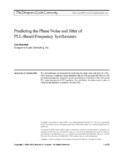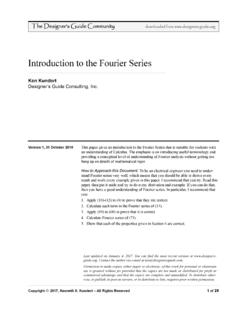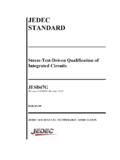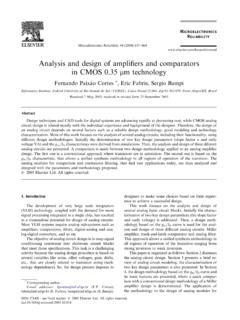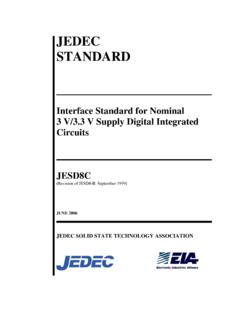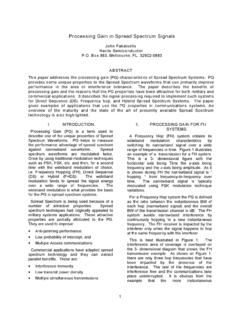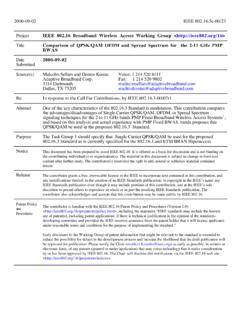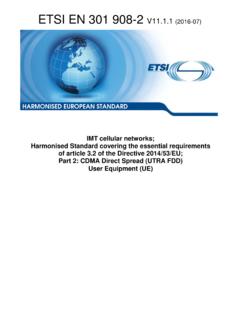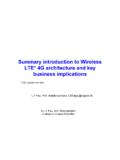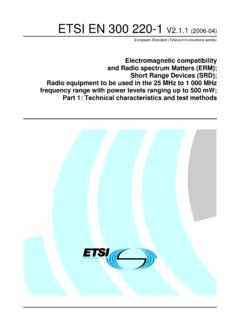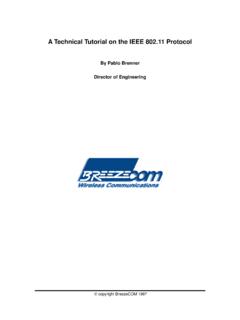Transcription of Introduction to RF Simulation and its Application
1 The Designer s Guide Communitydownloaded from 2010, Kenneth S. Kundert All Rights Reserved1 of 47 Version 2, 23 April 2003 Radio-frequency (RF) circuits exhibit several distinguishing characteristics that makethem difficult to simulate using traditional Spice transient analysis. The various exten-sions to the harmonic balance and shooting method Simulation algorithms are able toexploit these characteristics to provide rapid and accurate Simulation for these paper is an Introduction to RF Simulation methods and how they are applied tomake common RF measurements.
2 It describes the unique characteristics of RF circuits,the methods developed to simulate these circuits, and the Application of these in the IEEE Journal of Solid-State Circuits, vol. 34, no. 9 in September 1999. Lastupdated on October 28, 2010 1:34 pm. Errors were found in (61), (62) and (64) that have beencorrected in this version. You can find the most recent version at the author via e-mail at to make copies, either paper or electronic, of this work for personal or classroom useis granted without fee provided that the copies are not made or distributed for profit or commer-cial advantage and that the copies are complete and unmodified.
3 To distribute otherwise, to pub-lish, to post on servers, or to distribute to lists, requires prior written to RF Simulation and its ApplicationKen KundertDesigner s Guide Consulting, to RF Simulation and its ApplicationThe RF Interface2 of 47 The Designer s Guide The RF InterfaceWireless transmitters and receivers can be conceptually separated into baseband and RFsections. Baseband is the range of frequencies over which transmitters take their inputand receivers produce their output. The bandwidth of the baseband section determinesthe underlying rate at which data can flow through the system.
4 There is a considerableamount of signal processing that occurs at baseband designed to improve the fidelity ofthe data stream being communicated and to reduce the load the transmitter places on thetransmission medium for a particular data rate. The RF section of the transmitter isresponsible for converting the processed baseband signal up to the assigned channel andinjecting the signal into the medium. Conversely, the RF section of the receiver isresponsible for taking the signal from the medium and converting it back down to transmitters there are two primary design goals.
5 First, they must transmit a speci-fied amount of power while consuming as little power as possible. Second, they mustnot interfere with transceivers operating on adjacent channels. For receivers, there arethree primary design goals. First, they must faithfully recover small signals. They mustreject interference outside the desired channel. And, like transmitters, they must be fru-gal power Small Desired SignalsReceivers must be very sensitive to detect small input signals. Typically, receivers areexpected to operate with as little as 1 V at the input.
6 The sensitivity of a receiver islimited by the noise generated in the input circuitry of the receiver. Thus, noise is aimportant concern in receivers and the ability to predict noise by Simulation is veryimportant. As shown in Figure 1, a typical superheterodyne receiver first filters and thenamplifies its input with a low noise amplifier or LNA. It then translates the signal to theintermediate frequency or IF by mixing it with the first local oscillator or LO. The noiseperformance of the front-end is determined mainly by the LNA, the mixer, and the it is possible to use traditional SPICE noise analysis to find the noise of the LNA,it is useless on the mixer and the LO because the noise in these blocks is strongly influ-enced by the large LO small input signal level requires that receivers must be capable of a tremendousamount of amplification.
7 Often as much as 120 dB of gain is needed. With such highgain, any coupling from the output back to the input can cause problems. One importantreason why the superheterodyne receiver architecture is used is to spread that gain overseveral frequencies to reduce the chance of coupling. It also results in the first LO beingFIGURE 1A coherent superheterodyne receiver s RF ( LO2t)RF FilterIF FilterLF Filtercos( LO2t)LF FilterIQCharacteristics of RF CircuitsIntroduction to RF Simulation and its Application3 of 47 The Designer s Guide a different frequency than the input, which prevents this large signal from contami-nating the small input signal.
8 For various reasons, the direct conversion or homodynearchitecture is a candidate to replace the superheterodyne architecture in some wirelesscommunication systems [1,16,47,48]. In this architecture the RF input signal is directlyconverted to baseband in one step. Thus, most of the gain will be at baseband and theLO will be at the same frequency as the input signal. In this case, the ability to deter-mine the impact of small amounts of coupling is quite important and will require carefulmodeling of the stray signal paths, such as coupling through the substrate, betweenpackage pins and bondwires, and through the supply Large Interfering SignalsReceivers must be sensitive to small signals even in the presence of large interferingsignals, often known as blockers.
9 This situation arises when trying to receive a weak ordistant transmitter with a strong nearby transmitter broadcasting in an adjacent interfering signal can be 60-70 dB larger than the desired signal and can act toblock its reception by overloading the input stages of the receiver or by increasing theamount of noise generated in the input stage. Both of these problems result if the inputstage is driven into a nonlinear region by the interferer. To avoid these problems, thefront-end of a receiver must be very linear. Thus, linearity is also an important concernin receivers.
10 Receivers are narrowband circuits and so the nonlinearity is quantified bymeasuring the intermodulation distortion. This involves driving the input with two sinu-soids that are in band and close to each other in frequency and then measuring the inter-modulation products. This is generally an expensive Simulation with SPICE becausemany cycles must be computed in order to have the frequency resolution necessary tosee the distortion Adjacent Channel InterferenceDistortion also plays an important role in the transmitter where nonlinearity in the out-put stages can cause the bandwidth of the transmitted signal to spread out into adjacentchannels.
